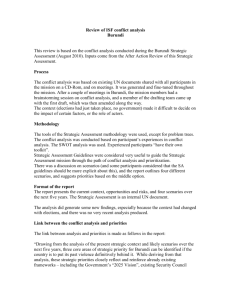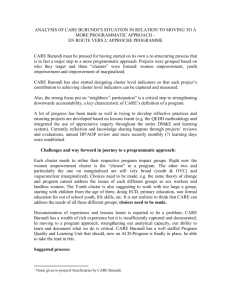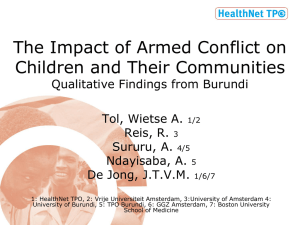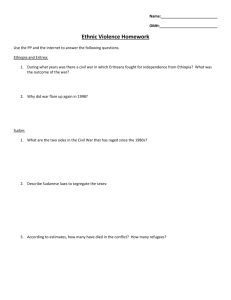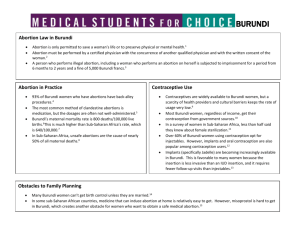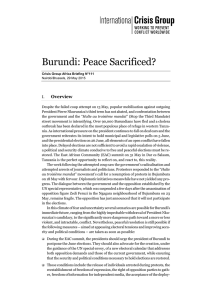Burundi
advertisement
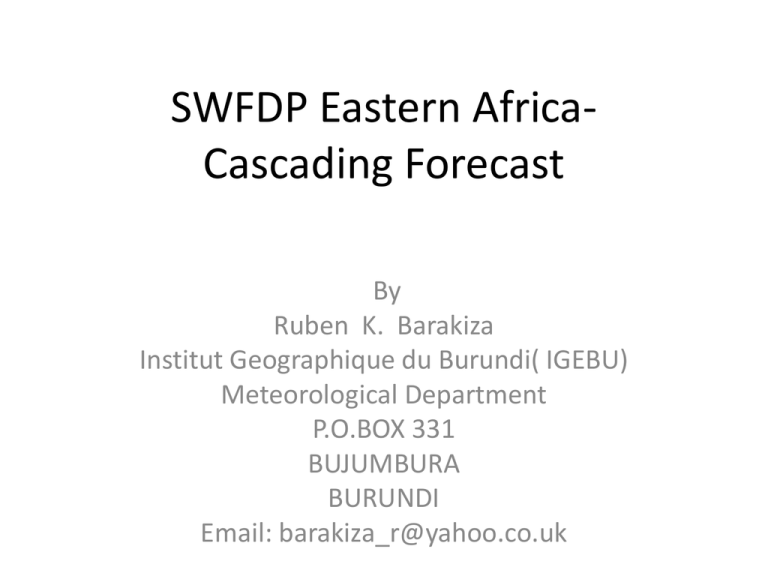
SWFDP Eastern AfricaCascading Forecast By Ruben K. Barakiza Institut Geographique du Burundi( IGEBU) Meteorological Department P.O.BOX 331 BUJUMBURA BURUNDI Email: barakiza_r@yahoo.co.uk • Objective • The provision of timely and effective information – through identified institutions – that allows individuals exposed to a hazard to take adequate actions to avoid or reduce their risk and prepare for effective response Extreme weather events • Currently, the SWFD focuses on the following weather extreme events: • Heavy rains • Strong winds associated with thunderstorms • Dry spells • Ocean/lake waves • Target users • Department of Disaster Management and Public Safety Authority • General public, • Various socio-economic institutions impacted by weather/climate The Cascading Forecasting Process • In the framework of the general organization of the Global Data-Processing and Forecasting System (GDPFS), the SWFDP implies a co-ordinated functioning among three types of GDPFS centres. • These are: Global NWP Centres to provide available NWP products, including in the form of probabilities; Regional Centres to interpret information received from the global NWP centres, run limited-area models to refine products, liaise with the participating NMCs; The NMCs to issue alerts, advisories, severe weather warnings; to liaise and collaborate with Media, and Disaster Management and CivilPprotection Authorities; and to contribute to the evaluation of the project. Cascading FCST ( cont’d) The first phase of this project commenced October 2011 and focused on: • heavy rain, • strong winds, • sea/lake waves, and • prolonged dry spells. The participating Services and Centres in the SWFDP Eastern Africa include: • NMHSs: Kenya, Burundi, Ethiopia, Rwanda, Tanzania and Uganda • Regional Centres: RSMC, KMD - Nairobi, RSMC, TMA - Dar es Salaam; and • Global Products Centres: • European Centre for Medium Range Weather Forecast( ECMWF) • Exeter (Met Office UK), • Washington (NOAA/NCEP ), and • DWD (Germany) NWP Product Analysis • Analysis of national observational data • Regional Productsfrom the RSMC-Nairobi Extreme weather guidance Risk table Cosmos model products Lake Victoria project • Internatinal Centres ECMWF Determistic forecasts and EPS Rainfall model products • NOAA NWP products, including: 10-day precipitation forecasts, wind flow forecast, Atmospheric Instability indices • Uk Metoffice products • EUMETSAT Products: satellite imagery, vertical atmosphere sounding CURREWNT STATUS OF OBSERVATIONAL NETWORK IN BURUNDI The current status of meteorological observational network in Burundi is as follows: • 2 synoptic stations operating 24 hours per day. • 13 main climatological stations • 125 rainfall stations • 43 hydrometric stations at main rivers such as Ruvubu, Rusizi and Malagarazi rivers from where hydrological measurements are carried out and data collected. • 5 Automatic Weather Stations (AWS) • EUMETSAT AMESD-PUMA satellite data station National Meteorological Observational Network in Burundi ECMWF Deterministic Forecast for Bujumbura, 01/04/2013 ECMWF 6-hour Rainfall Model Forecast over Burundi on 01/04/2013 ( 06UTC-12UTC) NOAA 10-day Precipitation Forecast, 18-25 May 2013 NOAA/GFS 850hpa Temperature, Relative humidity and Streamlines NOAA/GFSPrecipitable water, and Convective Available Potential Energy(CAPE) on 18/05/2013 00h CAPE • Convective available potential energy(CAPE),is the amount of energy a parcel of air would have if lifted a certain distance vertically through the atmosphere. • CAPE is effectively the positive buoyancy of an air parcel and is an indicator of atmospheric instability, • It is very valuable in predicting severe weather. CAPE Values Potential Weather 1000 - 3000 J kg-1 Deep Convection 5000 - 7000 J kg-1 Maximum Values- (extreme atm. instability) RSMC-NAIROBI OUNTRY RISK TABLE - Day 1: Monday 1st April, 2013 HEAVY RAIN STRONG WINDS LARGE WAVES RISK RISK RISK No BURUNDI Low X KENYA RWANDA Med No Low X C,S,W& NE X TANZANIA High Med High No X X E X N,E, C & SW Low X Off SE Coast E UGANDA S X X ETHIOPIA S X X Med H i g h RSMC-NAIROBI Risk Table-Day 2: Tuesday 2nd April, 2013 COUNTRY HEAVY RAIN RISK No BURUNDI Low X High No LARGE WAVES RISK RISK Low X KENYA RWANDA Med STRONG WINDS C&W X TANZANIA Med High No X X E X N&C Low X Off SE Coast E UGANDA X X X ETHIOPIA S X X Med H i g h EUMETSAT, 2013-04-01 IR image at 1200UTC Case study: Example of 16 April, 2013 • Risk table: Low risk of Rainfall>50mm/24h • Guidance forecast from RSMC-Nairobi showed that much of the country expected rainfall> 50mm/24h • On 15 April, 2013: A warning for heavy rains was issued. • What happened on the ground • In the Eastern parts of Burundi, in Ruyigi Province, Muriza weather station recorded 108.6mm/24h on 16/04/2013 . RISK TABLE Day 1: Monday 15th April, 2013 Issue Monday 15th April, 2013 COUNTRY HEAVY RAIN STRONG WINDS LARGE WAVES RISK RISK RISK No Low BURUNDI W KENYA W&C RWANDA W TANZANIA Off E Coast UGANDA ETHIOPIA X SW Medium High No Low Medium X Coast High No Low M H edi i um g h X Coast E X X Off SE Coast E X X X X RISK TABLE DAY 2: Tuesday 16th April, 2013 COUNTRY HEAVY RAIN STRONG WINDS LARGE WAVES RISK RISK RISK No Low BURUNDI X KENYA SW RWANDA X TANZANIA N&W UGANDA ETHIOPIA X SW Medium High No Low X Coast Medium High No Me H diu i m g h X Coast X Off E Coast Low E X Off SE Coast E X X X X Guidance Forecast for Tuesday 16th April, 2013 2013 April 16th , 24h-Total rainfall over Burundi Information Dissemination and communication • The Burundi NMHS dissemites and weather information to the socio-economic sectors and to the general public through various facilities such as: • National Radio broadcating • Telephone • Internet-emails • Gaps: Lack of television presentation, Lack of MOU with Newspapers Lack of allocated budget for providing weather information ( for instance, newspapers) Relationship with disaster management and civil protection authorities and media A networking and viable communication links exist between Burundi NMHS and the Disaster Management and Civil Protection Office. The National Platform for disaster Management has a representative from the Burundi NMHS UNDP-funded workshops focusing on Disaster prevention and preparedness have been organized aimed at capacity building of DMCPA, Media, NMHS and other concerned institutions. Media have been important means for disseminating information on extreme weather events. Challenges • Most extreme weather events such as hail, strong winds, etc. are associated with small scale thunderstorms, sometimes not materialized by global models. • Inadequate feedback from user community • Low level of awareness and disaster preparedness in the general public leading to low coping capacity. • THE END • THANK YOU FOR LISTENNING !!!
